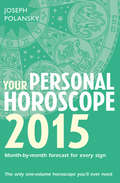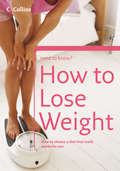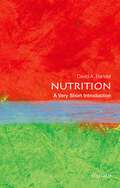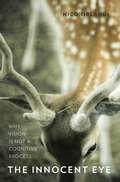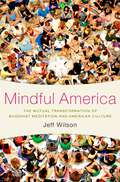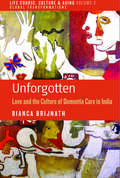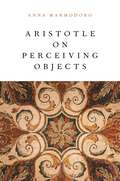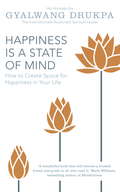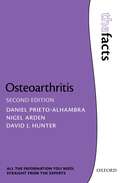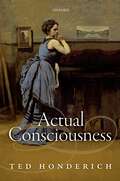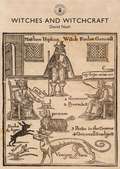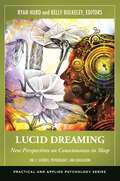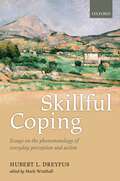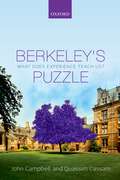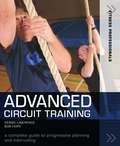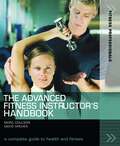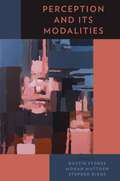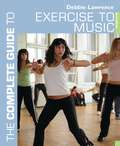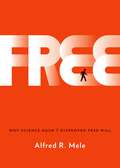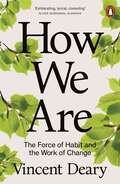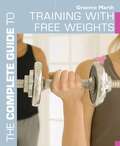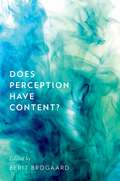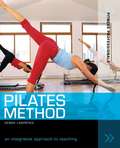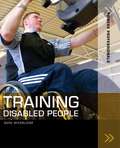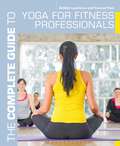- Table View
- List View
Your Personal Horoscope 2015: Month-by-month Forecasts For Every Sign
by Joseph PolanskyYour complete one-volume guide to the year 2015. This fantastic and in-depth book includes month-by-month forecasts for every sign and all you need to know to find out what is in store for you in the year ahead. The only one-volume horoscope you’ll ever need.
How to Lose Weight (Collins Need to Know?)
by Christine MichaelThis one-stop practical guide will show you how to lose weight in the way that’s best suited to your body and lifestyle. To make your progress easier, it comes in a handy format with colour illustrations and expert advice throughout.
Nutrition: A Very Short Introduction (Very Short Introductions)
by David BenderNutrition is a topic of wide interest and importance. In spite of growing understanding of the underlying biochemistry, and health campaigns such as 'five-a-day', increasing obesity and reported food allergies and eating disorders, as well as the widely advertised 'supposed' benefits of food supplements mean that a clear explanation of the basic principles of a healthy diet are vital. In this Very Short Introduction, David Bender explains the basic elements of food, the balance between energy intake and exercise, the problems of over- and under-nutrition, and raises the question of safety of nutritional supplements. ABOUT THE SERIES: The Very Short Introductions series from Oxford University Press contains hundreds of titles in almost every subject area. These pocket-sized books are the perfect way to get ahead in a new subject quickly. Our expert authors combine facts, analysis, perspective, new ideas, and enthusiasm to make interesting and challenging topics highly readable.
The Innocent Eye: Why Vision Is Not a Cognitive Process (Philosophy of Mind)
by Nico OrlandiWhy does the world look to us as it does? Generally speaking, this question has received two types of answers in the cognitive sciences in the past fifty or so years. According to the first, the world looks to us the way it does because we construct it to look as it does. According to the second, the world looks as it does primarily because of how the world is. In The Innocent Eye, Nico Orlandi defends a position that aligns with this second, world-centered tradition, but that also respects some of the insights of constructivism. Orlandi develops an embedded understanding of visual processing according to which, while visual percepts are representational states, the states and structures that precede the production of percepts are not representations. If we study the environmental contingencies in which vision occurs, and we properly distinguish functional states and features of the visual apparatus from representational states and features, we obtain an empirically more plausible, world-centered account. Orlandi shows that this account accords well with models of vision in perceptual psychology -- such as Natural Scene Statistics and Bayesian approaches to perception -- and outlines some of the ways in which it differs from recent 'enactive' approaches to vision. The main difference is that, although the embedded account recognizes the importance of movement for perception, it does not appeal to action to uncover the richness of visual stimulation. The upshot is that constructive models of vision ascribe mental representations too liberally, ultimately misunderstanding the notion. Orlandi offers a proposal for what mental representations are that, following insights from Brentano, James and a number of contemporary cognitive scientists, appeals to the notions of de-coupleability and absence to distinguish representations from mere tracking states.
Mindful America: The Mutual Transformation of Buddhist Meditation and American Culture
by Jeff WilsonThirty years ago, "mindfulness" was a Buddhist principle mostly obscure to the west. Today, it is a popular cure-all for Americans' daily problems. A massive and lucrative industry promotes mindfulness in every aspect of life, however mundane or unlikely: Americans of various faiths (or none at all) practice mindful eating, mindful sex, mindful parenting, mindfulness in the office, mindful sports, mindfulness-based stress relief and addiction recovery, and hire mindful divorce lawyers. Mindfulness is touted by members of Congress, CEOs, and Silicon Valley tech gurus, and is even being taught in public schools, hospitals, and the military. Focusing on such processes as the marketing, medicalization, and professionalization of meditation, Jeff Wilson reveals how Buddhism shed its countercultural image and was assimilated into mainstream American culture. The rise of mindfulness in America, Wilson argues, is a perfect example of how Buddhism enters new cultures and is domesticated: in each case, the new cultures take from Buddhism what they believe will relieve their specific distresses and concerns, and in the process create new forms of Buddhism adapted to their needs. Wilson also tackles the economics of the mindfulness movement, examining commercial programs, therapeutic services, and products such as books, films, CDs, and even smartphone applications. Mindful America is the first in-depth study of this phenomenon--invaluable for understanding how mindfulness came to be applied to such a vast array of non-religious concerns and how it can be reconciled with traditional Buddhism in America.
Unforgotten: Love and the Culture of Dementia Care in India (Life Course, Culture and Aging: Global Transformations #2)
by Bianca BrijnathAs life expectancy increases in India, the number of people living with dementia will also rise. Yet little is known about how people in India cope with dementia, how relationships and identities change through illness and loss. In addressing this question, this book offers a rich ethnographic account of how middle-class families in urban India care for their relatives with dementia. From the husband who wakes up at 3 am to feed his wife ice-cream to the daughters who gave up employment for seven years to care for their mother with dementia, this book illuminates the local idioms on dementia and aging, the personal experience of care-giving, the functioning of stigma in daily life, and the social and cultural barriers in accessing support.
Aristotle on Perceiving Objects
by Anna MarmodoroHow can we explain the structure of perceptual experience? What is it that we perceive? How is it that we perceive objects and not disjoint arrays of properties? By which sense or senses do we perceive objects? Are our five senses sufficient for the perception of objects? Aristotle investigated these questions by means of the metaphysical modeling of the unity of the perceptual faculty and the unity of experiential content. His account remains fruitful-but also challenging-even for contemporary philosophy. This book offers a reconstruction of the six metaphysical models Aristotle offered to address these and related questions, focusing on their metaphysical underpinning in his theory of causal powers. By doing so, the book brings out what is especially valuable and even surprising about the topic: the core principles of Aristotle's metaphysics of perception are fundamentally different from those of his metaphysics of substance. Yet, for precisely this reason, his models of perceptual content are unexplored territory. This book breaks new ground in offering an understanding of Aristotle's metaphysics of the content of perceptual experience and of the composition of the perceptual faculty.
Happiness is a State of Mind: How to Create Space for Happiness in Your Life
by His Holiness DrukpaWe are all chasing happiness. We spend our lives searching for that one thing we think will finally make us happy. But is happiness something deeper than that, more fundamental? How can universal happiness be achieved?His Holiness the Gyalwang Drukpa reveals that the secret to happiness lies in the mind. Exploring the simple ways we can train our minds to recognise a happiness that is already there, he gives us the tools to embrace an appreciation for life as it is, rather than as we feel it should be, and helps us flourish as individuals, and as part of the wider world.With Happiness is a State of Mind you can choose to make today a happy one.
Osteoarthritis: The Facts (The Facts Series)
by Daniel Prieto-Alhambra Nigel Arden David J. HunterOsteoarthritis: The Facts helps patients and their carers better understand the condition, empowering patients with the knowledge and skills to actively take charge of their own health by knowing as much as they can about osteoarthritis, and finding out how this can be best managed. Part 1 details what osteoarthritis is, what causes it, who it affects, what the main symptoms are, how it is diagnosed, and what the long-term outcome is. Part 2 explains the potential aspects of management that can be used for osteoarthritis, including self-management strategies, exercise, diet, medications, surgical treatments, and alternative therapies. Osteoarthritis: The Facts also includes a useful resources section, including information on support groups and websites, providing the reader with an opportunity to educate and empower themselves with tools that will help reduce their suffering.
Actual Consciousness
by Ted HonderichWhat is it for you to be conscious? There is no agreement whatever in philosophy or science: it has remained a hard problem, a mystery. Is this partly or mainly owed to the existing theories not even having the same subject, not answering the same question? In Actual Consciousness, Ted Honderich sets out to supersede dualisms, objective physicalisms, abstract functionalism, externalisms, and other positions in the debate. He argues that the theory of Actualism, right or wrong, is unprecedented, in nine ways. (1) It begins from gathered data and proceeds to an adequate initial clarification of consciousness in the primary ordinary sense. This consciousness is summed up as something's being actual. (2) Like basic science, Actualism proceeds from this metaphorical or figurative beginning to what is wholly literal and explicit—constructed answers to the questions of what is actual and what it is for it to be actual. (3) In so doing, the theory respects the differences of consciousness within perception, consciousness that is thinking in a generic sense, and consciousness that is generic wanting. (4) What is actual with your perceptual consciousness is a subjective physical world out there, very likely a room, differently real from the objective physical world, that other division of the physical world. (5) What it is for the myriad subjective physical worlds to be actual is for them to be subjectively physical, which is exhaustively characterized. (6) What is actual with cognitive and affective consciousness is affirmed or valued representations. The representations being actual, which is essential to their nature, is their being differently subjectively physical from the subjective physical worlds. (7) Actualism, naturally enough when you think of it, but unlike any other existing general theory of consciousness, is thus externalist with perceptual consciousness but internalist with respect to cognitive and affective consciousness. (8) It satisfies rigorous criteria got from examination of the failures of the existing theories. In particular, it explains the role of subjectivity in thinking about consciousness, including a special subjectivity that is individuality. (9) Philosophers and scientists have regularly said that thinking about consciousness requires just giving up the old stuff and starting again. Actualism does this. Science is served by this main line philosophy, which is concentration on the logic of ordinary intelligence—clarity, consistency and validity, completeness, generality.
Witches and Witchcraft (Shire Library)
by David NashWitchcraft haunts the Western imagination to this day, from Central Europe to Britain to North America. This book explores the development of witchcraft and of the belief in it (stressing the difference between the two), the sixteenthand seventeenth-century obsession that spawned witch-hunting, the eventual decline of witchcraft, and the phenomenon's fascinating 'afterlife' that has involved the Nazis' fixation and modern treatments including Arthur Miller's acclaimed The Crucible. Fully illustrated with historical documents and colour photographs, and expertly written by Professor David Nash, this book is the perfect introduction to a subject that is compelling, disturbing and a little-understood cultural touchstone.
Lucid Dreaming [2 volumes]: New Perspectives on Consciousness in Sleep [2 volumes] (Practical and Applied Psychology)
In this fascinating new collection, an all-star team of researchers explores lucid dreaming not only as consciousness during sleep but also as a powerful ability cultivated by artists, scientists, and shamans alike to achieve a variety of purposes and outcomes in the dream.The first set of its kind, Lucid Dreaming: New Perspectives on Consciousness in Sleep provides a comprehensive showcase of the theories, research, and direct experience that serve to illuminate how certain people can maintain conscious awareness while dreaming. The text is organized into two sections, covering science, psychology, and education; and religious traditions, creativity, and culture. Contributors to this two-volume work include top dream experts across the globe—scholars sharing knowledge gained from deep personal explorations and cutting-edge scientific investigations.Topics covered include the neuroscience of lucid dreaming, clinical uses of lucid dreaming in treating trauma, the secret history of lucid dreaming in English philosophy, and spiritual practices of lucid dreaming in Islam, Buddhism, and shamanic traditions. The work also addresses lucid dreaming in movies including The Matrix and literature such as the fiction of J.R.R. Tolkien and explains how modern video gaming enhances lucidity. This set serves as an ideal text and reference work for school libraries and academic courses in anthropology, psychology, religious studies, and cognitive science as well as for graduate-level study in holistic education—an increasingly popular specialization.
Skillful Coping: Essays on the phenomenology of everyday perception and action
by Hubert L. DreyfusFor fifty years Hubert Dreyfus has addressed an astonishing range of issues in the fields of phenomenology, existentialism, cognitive science, and the philosophical study of mind. Dreyfus has inspired a whole generation of philosophers as he has creatively drawn on and clearly articulated the seminal works of thinkers like Kierkegaard, Husserl, Heidegger, Merleau-Ponty and Foucault. This volume presents a selection of Dreyfus's most influential essays on mind and action. The book begins with a model of skillful engaged human action, which informs much of Dreyfus's philosophy, and was developed in collaboration with Stuart Dreyfus. The volume then presents articles developing a critique of the representational model of the mind in analytical philosophy of mind and mainstream cognitive science. Dreyfus argues that representational models of mind offer an impoverished and distorting account of human engagement with the world. The chapters show this by addressing issues in philosophy of mind and the cognitive sciences through the skill model.
Berkeley's Puzzle: What Does Experience Teach Us?
by John Campbell Quassim CassamSensory experience seems to be the basis of our knowledge and conception of mind-independent things. The puzzle is to understand how that can be: even if the things we experience (apples, tables, trees, etc), are mind-independent how does our sensory experience of them enable us to conceive of them as mind-independent? George Berkeley thought that sensory experience can only provide us with the conception of mind-dependent things, things which cannot exist when they aren't being perceived. It's easy to dismiss Berkeley's conclusion but harder to see how to avoid it. In this book, John Campbell and Quassim Cassam propose very different solutions to Berkeley's Puzzle. For Campbell, sensory experience can be the basis of our knowledge of mind-independent things because it is a relation, more primitive than thought, between the perceiver and high-level objects and properties in the mind-independent world. Cassam opposes this 'relationalist' solution to the Puzzle and defends a 'representationalist' solution: sensory experience can give us the conception of mind-independent things because it represents its objects as mind-independent, but does so without presupposing concepts of mind-independent things. This book is written in the form of a debate between two rival approaches to understanding the relationship between concepts and sensory experience. Although Berkeley's Puzzle frames the debate, the questions addressed by Campbell and Cassam aren't just of historical interest. They are among the most fundamental questions in philosophy.
Advanced Circuit Training: A Complete Guide to Progressive Planning and Instructing (Fitness Professionals)
by Richard Bob Hope Debbie LawrenceThere are around 60,000 qualified gym instructors and personal trainersin the UK alone, with several thousand more qualifying each year. TheRegister of Exercise Professionals' (REPs) Level 3 qualification isseen as the principal goal for all instructors, and a key part of thisis advanced circuit training.Fitness Professionals: Advanced Circuit Training is the advanced companion to the definitive Fitness Professionals: Circuit Training.Building on the basics of the first book, this new title is the onlybook in the market that specifically deals with more complex andinnovative circuit methods - including kettlebell exercises, boxerciseand increasingly popular 'boot camp' military-style exercise - andwhich actively helps trainers in the industry achieve theirprofessional qualifications. Using step-by-step guidance to planningand coordinating sessions and illustrated by quality photographs, Advanced Circuit Training is written in accordance with REPs national standards for Level 3.
The Advanced Fitness Instructor's Handbook (Fitness Professionals)
by Morc Coulson David ArcherThe Advanced Fitness Instructor's Handbook follows on from The Fitness Instructor's Handbook.It is the first textbook to cover the National Occupational Standardsand the Qualifications framework for Level 3 and Level 4 Instructorsteaching Exercise and Fitness - required to teach one-on-one, and thestandards which gyms are increasingly expecting staff to attain.
Perception and Its Modalities
This volume is about the many ways we perceive. In nineteen new essays, philosophers and cognitive scientists explore the nature of the individual senses, how and what they tell us about the world, and how they interrelate. They consider how the senses extract perceptual content from receptoral information and what kinds of objects we perceive and whether multiple senses ever perceive a single event. Questions pertaining to how many senses we have, what makes one sense distinct from another, and whether and why distinguishing senses may be useful feature prominently. Contributors examine the extent to which the senses act in concert, rather than as discrete modalities, and whether this influence is epistemically pernicious, neutral, or beneficial. Many of the essays engage with the idea that it is unduly restrictive to think of perception as a collation of contents provided by individual sense modalities. Rather, contributors contend that to understand perception properly we need to build into our accounts the idea that the senses work together. In doing so, they aim to develop better paradigms for understanding the senses and thereby to move toward a better understanding of perception.
The Complete Guide to Exercise to Music
by Debbie LawrenceThe Complete Guide to Exercise to Music(3rd edition) is a practical handbook for the regular exerciser whowishes to know more about the enormous benefits of training to music,and the fitness professional who seeks a thorough grounding in Level 2and 3 knowledge.This 3rd edition is fully updated to include:- Aspects of the core and skills-based knowledge for Level 2 and 3 ETM instructors- The latest research on safety in the exercise environment- Adapting ETM for special populations- Over 200 colour photographs demonstrating stretches and exercisesExerciseto Music is one of the core modules of the Level 2 gym instructorssyllabus, and a new Level 3 qualification was added in January 2008.This edition will cover all this knowledge, using revision notes andtests as useful tools for the readers' study. The Complete Guide to Exercise to Music therefore aims to become the reference on this discipline for everyone involved in the health and fitness industry.
Free: Why Science Hasn't Disproved Free Will
by Alfred R. MeleDoes free will exist? The question has fueled heated debates spanning from philosophy to psychology and religion. The answer has major implications, and the stakes are high. To put it in the simple terms that have come to dominate these debates, if we are free to make our own decisions, we are accountable for what we do, and if we aren't free, we're off the hook. There are neuroscientists who claim that our decisions are made unconsciously and are therefore outside of our control and social psychologists who argue that myriad imperceptible factors influence even our minor decisions to the extent that there is no room for free will. According to philosopher Alfred R. Mele, what they point to as hard and fast evidence that free will cannot exist actually leaves much room for doubt. If we look more closely at the major experiments that free will deniers cite, we can see large gaps where the light of possibility shines through. In Free: Why Science Hasn't Disproved Free Will, Mele lays out his opponents' experiments simply and clearly, and proceeds to debunk their supposed findings, one by one, explaining how the experiments don't provide the solid evidence for which they have been touted. There is powerful evidence that conscious decisions play an important role in our lives, and knowledge about situational influences can allow people to respond to those influences rationally rather than with blind obedience. Mele also explores the meaning and ramifications of free will. What, exactly, does it mean to have free will -- is it a state of our soul, or an undefinable openness to alternative decisions? Is it something natural and practical that is closely tied to moral responsibility? Since evidence suggests that denying the existence of free will actually encourages bad behavior, we have a duty to give it a fair chance.
How We Are: Book One Of The How To Live Trilogy (How To Live Trilogy Ser. #1)
by Vincent DearyWe live in small worlds. An astonishing literary debut and the first book in the monumental How To Live trilogy, How We Are explores the power of habit and the difficulty of change. A story told in three parts, this profound and ambitious trilogy gets right to the heart of what it means to be human: how we work, how we break, and how we mend.As Vincent Deary shows us, we live most of our lives automatically, in small worlds of more or less comfortable routine - what he calls Act One. Conscious change requires deliberate effort, and so, for the most part, we avoid it. But inevitably, from within or without, something will come along to disturb our small worlds - some News From Elsewhere. And with ingrained reluctance, we begin the work of adjustment: Act Two.Over decades of psychotherapeutic work, Deary has been a witness to the theatre of change - the way that ordinary people get stuck, struggle with new circumstances, and eventually transform their lives and get better. He is also keenly aware that novelists, poets, philosophers and theologians have grappled with these experiences for far longer than psychologists have. Drawing on his own personal experience, and a staggering range of literary, philosophical and cultural sources, Deary has produced a mesmerizing and universal portrait of the human condition.Part psychologist, part philosopher, part novelist, Deary helps us to see how we can resist being mere habit machines, and make our acts and our lives more fully our own.Vincent Deary is a health psychologist at Northumbria University. This, his first book, is part one of the How To Live trilogy, and will be followed by How We Break (book 2) and How We Mend (book 3).
The Complete Guide to Training with Free Weights
by Graeme MarshA key title in the successful Complete Guides series, this is the definitive text on using free weights for strength, conditioning and flexibility training.Free weights are the simplest and most effective pieces of equipment and are found in every gym and many homes. The benefits of their use - as opposed to fixed-weight machines - are becoming increasingly appreciated in the fitness industry, and include:saving money on gym membership with home workoutsa wider range of exercisesexercises working more muscles than fixed machines for a quicker workoutavoiding over-training single muscle groups, which can lead to strength imbalancesbetter co-ordination and core stabilityIn addition to a variety of exercises, the book will also contain sample programmes, tips on technique, and exercises for specific sports, ages and body types.
Does Perception Have Content? (Philosophy of Mind)
Within the contemporary philosophical debates over the nature of perception, the question of whether perception has content in the first place recently has become a focus of discussion. The most common view is that it does, but a number of philosophers have questioned this claim. The issue immediately raises a number of related questions. What does it mean to say that perception has content? Does perception have more than one kind of content? Does perceptual content derive from the content of beliefs or judgments? Should perceptual content be understood in terms of accuracy conditions? Is naive realism compatible with holding that perception has content? This volume brings together philosophers representing many different perspectives to address these and other central questions in the philosophy of perception.
Pilates Method: An integrative approach to teaching (Fitness Professionals)
by Debbie LawrenceFitness Professionals: Pilates Method is the first book to be written for the specific needs of Pilates instructors. It contains everything a new teacher needs to know in order to pass the national qualification and is an ideal reference for experienced instructors.Pilates is one of the most popular - and fastest growing - group exercise classes in the UK. For many years it has not been possible to write a definitive book for instructors as there have been many different schools of teaching. However, these have recently been brought together under a single national assessment, meaning that all Pilates instructors must have the same foundation knowledge.This book will cover these foundation subjects, which include:anatomy the key principles of Pilates assessment structuring a session teaching a session. Written to the requirements of the national standards, this book contains everything an instructor needs to know in order to successfully teach Pilates.
Training Disabled People (Fitness Professionals)
by Sara WicebloomTraining Disabled People is the only book to provide fitnessprofessionals with detailed guidance on working with disabled clients.The book is written to the National Standards, so provides the readerwith everything they need to know in order to gain qualification and beable to work safely and effectively with disabled clients. Training disabled clients is currently the most in-demand course atmany of the fitness industry training centres - they are struggling tokeep up with demand. This follows legislation and Governmentinitiatives designed to improve access to fitness centres for disabledpeople and to encourage them to take part in regular exercise. The book covers a range of areas, including: medical conditions and how to research them programming and instruction skills pre-exercise checks and fitness testing communication skills (including sign language) motivation techniques sample programmes and exercises, fully illustrated with B&W photographychecklists and forms to be used when working with clients.
The Complete Guide to Yoga for Fitness Professionals
by Debbie Lawrence Conrad PaulThe Complete Guide to Yoga for Fitness Professionals gives you the necessary skills to become a successful yoga teacher or practitioner. Whether you are looking for information on planning, structuring and delivering a yoga class, or are looking to increase your general understanding and appreciation of the history and ancient lineage of yoga, our experienced authors are here to help.Reaching beyond the typical 'how to' guides, this book not only covers the basics but also details more advanced teaching techniques. Master how to teach the classic asana pose, including the benefits, precautions, prohibitions and modifications of a selection of some other Hatha yoga postures. Higher level yoga practices are found in Part Three, along with information about how to deal with common conditions of participants encountered in a yoga class and any adaptations that need to be made to support them.
